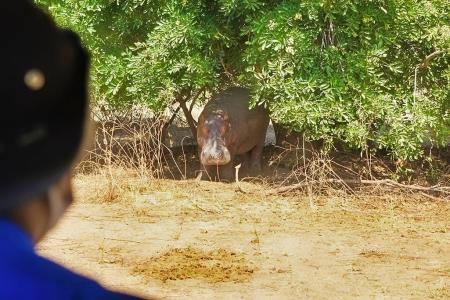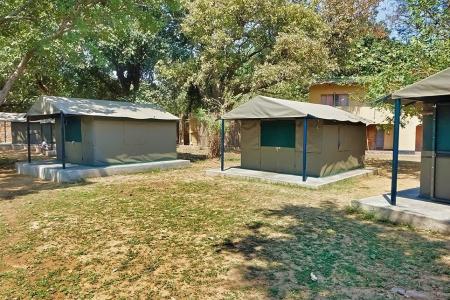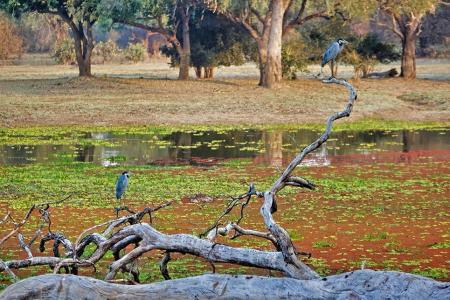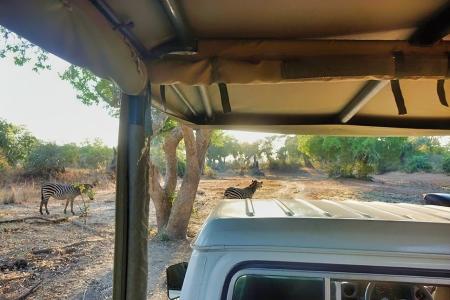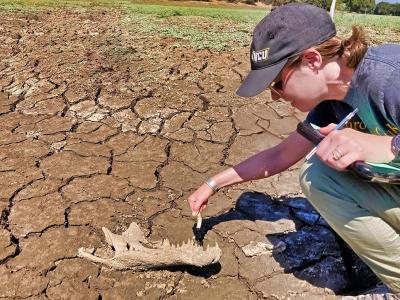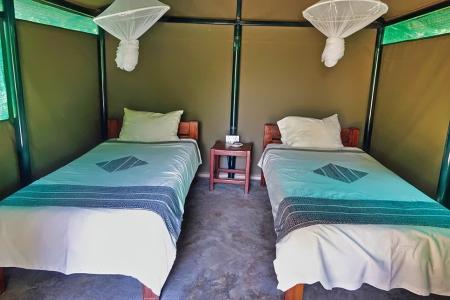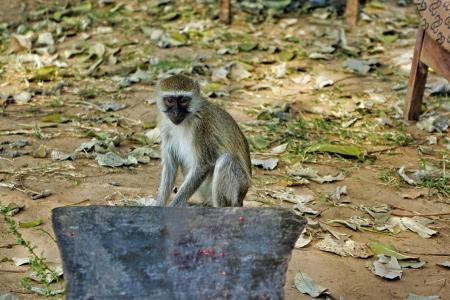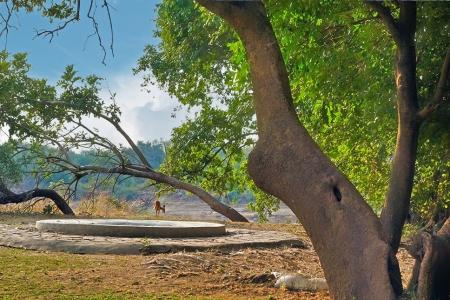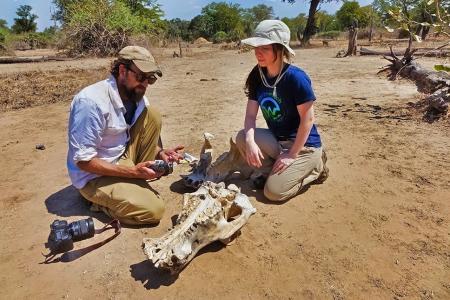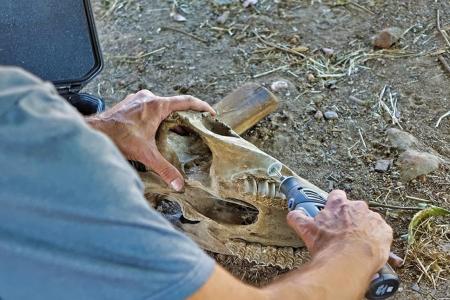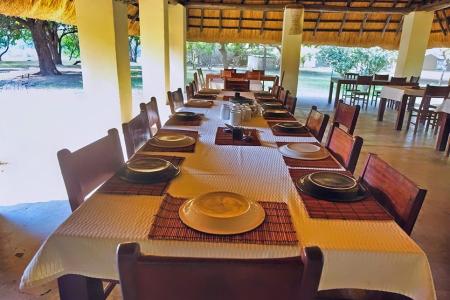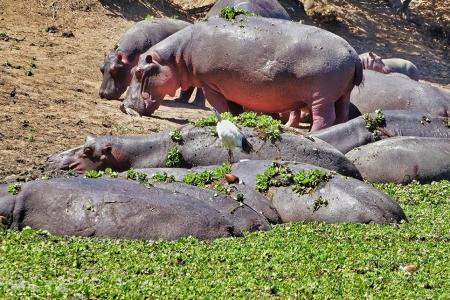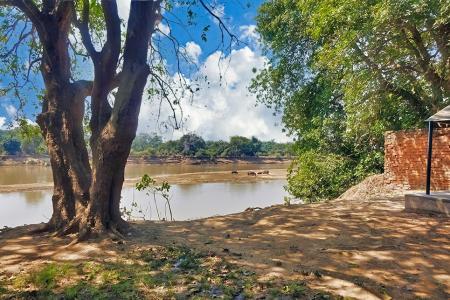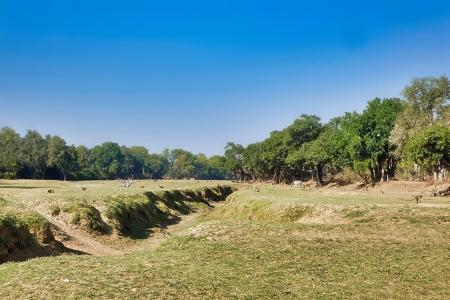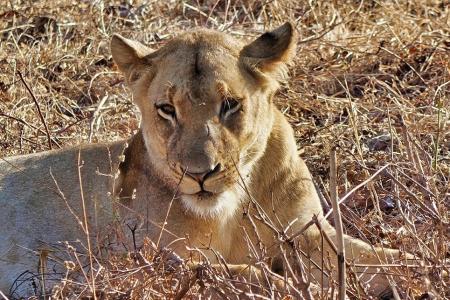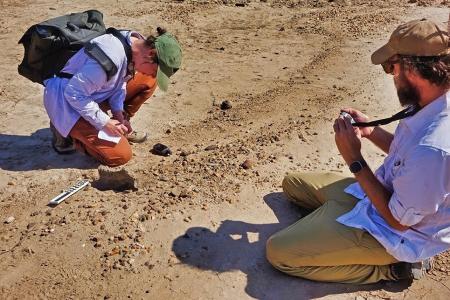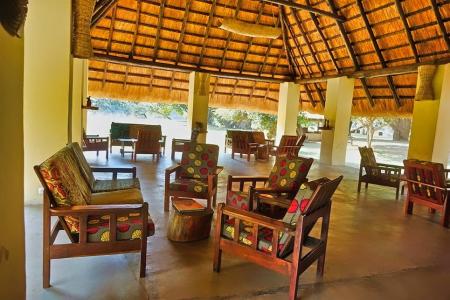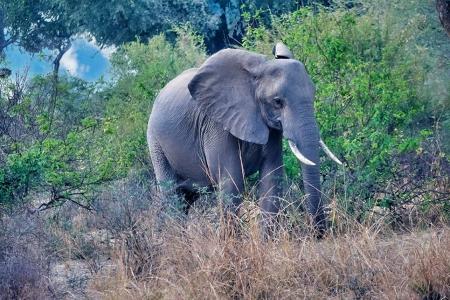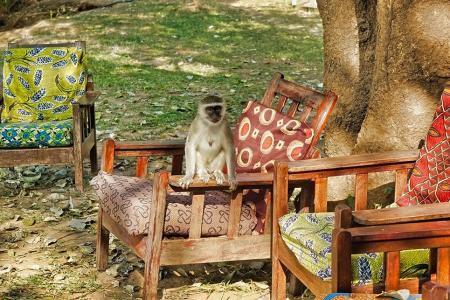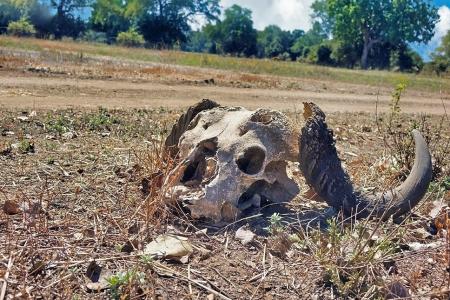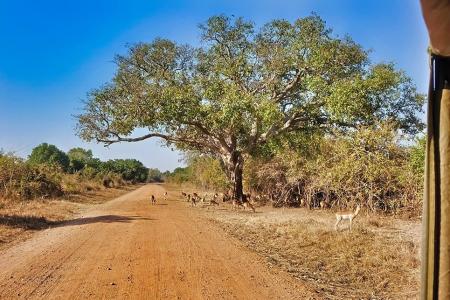Please read the following information carefully before leaving for your expedition.
Wildlife, Bones, and History in Zambia
Expedition Briefing
Quick Navigation: COVID-19 Safety | The Research | Research Aims | How You Will Help | Life in the Field | Accommodations and Food | Project Conditions | Essential Eligibility Requirements | Health and Safety | Project Risks and Precautions | Travel Planning | Additional Resources
Click on the images to view full size!
COVID-19 Safety
You are strongly encouraged to test for COVID-19 before traveling to your expedition, particularly if you are experiencing symptoms. Do not travel if you have tested positive, and call Earthwatch right away for the next steps. Please see earthwatch.org/covid-19 for more information.
The Research
Zambia is well known for its populations of endangered carnivores, variety of wildlife, and preserved natural areas. Scientists and conservationists have been working on the ground to safeguard Zambia’s animals and ecosystems in the face of pollution, poaching, and land degradation. These efforts are becoming increasingly urgent as the climate crisis further threatens the country’s biodiversity by increasing the severity and unpredictability of Zambia's flooding, droughts, and seasonality (Hamadudu & Ngoma, 2019). To understand how to best manage these impacts in the future, we’re looking to the past to learn how climatic changes affect species distribution and survival.
On this project, you’ll work alongside an expert team of scientists to combine bone and live-animal surveys to explore how climate and mammalian communities are preserved and have changed over time in the Luangwa River Valley. By conducting surveys to document the bones of recently deceased animals, researchers will be able to study what taphonomic processes (the processes that affect animal and plant remains as they become fossils, like burial, decay, and preservation) are at play in present-day bone assemblages, allowing them to better interpret the fossil record (Behrensmeyer, Western, & Dechant Boaz, 1979).
Live animal surveys are one of the most accurate and cost-effective ways to estimate population sizes and assess climate change's influence on a given species' population (Schuette et al., 2018). By systematically assessing the species in the park and their numbers and locations, researchers can accurately assess the park’s current mammal communities and how current environmental conditions influence those populations.
These approaches will provide powerful tools for identifying changes in community structure, species richness, habitat utilization and diet, and predator-prey interactions over extended time scales (Dietl et al., 2014). This long-term approach to analyzing the wildlife communities of South Luangwa National Park will give us invaluable insights into the past and help us plan for conserving biodiversity in the future.
Wildlife, Bones, and History in Zambia
Research Aims
This project aims to explore the relationship between communities of modern and historical African mammals and ecological conditions over time in South Luangwa National Park. Data from this project will be used to address the following two research questions:
- Do mammalian communities differ across habitat types in the Luangwa River Valley?
- How do mammalian diets vary over time and space in the Luangwa River Valley? How can we better use this information to predict ecological responses to continued climate change?
Wildlife, Bones, and History in Zambia
How You Will Help
Earthwatch participants are critical for our project to meet our field research goals. You become trained in survey methods, identification of living animals and skeletal elements, and actively participate in collecting data across the expansive landscape of the South Luangwa National Park. Without your partnership, our team could not effectively sample many habitat types through time as the Luangwa River ebbs and flows. Your work is integral to the effectiveness of our scientific methods and the broad dissemination of the work to the academic and conservation communities.
When you first arrive at camp, you’ll receive an orientation and intensive training on research methods, and during the days that follow, you’ll work in small teams or pairs on the following tasks:
Bone Surveys
As a group accompanied by the researchers and an armed scout, you’ll walk transect paths in various habitat types to search for bones from recently deceased animals. For any bones you find, you’ll record the bone’s GPS coordinates, taxon, age, weathering stage, breakage, tooth marks, and degree of burial.
Wildlife Surveys
You’ll travel the park roads from a safari vehicle to survey wild animal populations. You may spot impalas, pukus, buffalo, waterbucks, the endangered Thornicroft’s giraffe, hippos, elephants, and even leopards, lions, or wild dogs. For each sighting, you’ll record the time, GPS location, distance from the vehicle, and taxonomic identification of the animal.
Wildlife, Bones, and History in Zambia
Life in the Field
The expedition begins with an introduction to the research and training. You’ll then spend your mornings in the South Luangwa National Park, alternating between the two research tasks: bone walks and live animal census drives. Once back at the lodge in the afternoons, you’ll have time to rest, help with specimen processing and data entry, watch the spectacular Zambian sunsets with your teammates, and talk with the scientists to learn more about their research.
You will also have the occasional (and optional) opportunity to participate in a recreational game drive for an added cost of USD 50–USD 60 per person, plus a mandatory $25 park entrance fee. Additionally, you will have the chance to visit the local shops selling beautiful handmade goods in the Mfuwe town center. The exact days and times for these activities will be determined while you are in the field.
DAILY ACTIVITIES
Weather and research needs can lead to changes in the daily schedule. We appreciate your cooperation and understanding.
- 7:00 a.m.: Breakfast at the lodge
- 8:00 a.m.: Drive to the park
- 8:00–12:00 p.m.: Alternate between the following tasks as needed:
- bone walk transects,
- live animal census driving transects.
- 12:00 p.m.: Lunch in the field
- 1:00 p.m.: Drive back to the lodge (can take anywhere from ~30 minutes–2 hours)
- 3:00 p.m.: Downtime
- 4:30– 6:00 p.m.: Recap of the day/data entry
- 6:00 p.m.: Optional team reflection time while watching the sunset (“sundowner”)
- 6:30 p.m. Dinner at the lodge
- 7:30 p.m. Occasional lectures and presentations by the scientists / Downtime
ITINERARY
Day 1: Meet in Mfuwe, travel to the lodge, settle in, and begin training.
Days 2–9* Fieldwork
- bone walk transects.
- live animal census driving transects.
- data entry
- occasional lectures
- optional recreation activities
Day 10: Pack and depart.
Money Matters
LOCAL CURRENCY
Zambian Kwacha
PERSONAL FUNDS
It is recommended that you convert the equivalent of 250–350 USD to Zambian Kwacha before you arrive for personal expenditures. You may need personal funds for laundry, internet, and snacks/alcoholic drinks. It is recommended that you arrive in the country with Kwacha or plan to withdraw money from the Lusaka or Mfuwe airport ATMs, as the ATMs in town often run out of money. You can use American currency in some places if the bills are undamaged and newer than 2018 (and even so, American dollars are often refused). British pounds are not widely accepted. If you plan to stay in Lusaka or Mfuwe for extra days, you may need a bit more. Tipping is not required in Zambia; however, leaving a tip for lodge staff upon departure is recommended. Visa and Mastercard are commonly taken in Lusaka but not in rural parts where most of the project is conducted.
Wildlife, Bones, and History in Zambia
Accommodations and Food
* Please note that not every expedition has couples or single accommodations available. Please call or email Earthwatch to check availability before reserving your space(s) on the team.
SLEEPING
Volunteers will stay at the Marula Lodge within a few minutes’ drive from the South Luangwa National Park entrance. The lodge sits along the Luangwa River and is fully immersed in the local wildlife. You’ll fall asleep each night to an orchestra of nature’s sounds, from the swimming hippos to the swinging baboons (earplugs recommended for lighter sleepers).
Volunteers will be housed in semi-permanent canvas tents, with each tent holding two single beds with mosquito netting, two type G electrical outlets, a fan, and one small bedside table. Mattress, bedding, and towels are provided. Volunteers of the same gender will be assigned two people per tent. Couples may be able to be accommodated but must inform Earthwatch of their request in advance. Tents available for couples will be assigned on a first-come, first-served basis. Volunteers must bring their toiletries (except for hand soap) and their own torches/ flashlights (a headlamp/torch is best). Please see the packing list for more details about what to bring with you.
* Earthwatch will honor each person’s assertion of gender identity respectfully and without judgment. For both teen and adult teams, where logistics dictate single-sex accommodations or other facilities, participant placements will be made in accordance with the gender identity the participant specified on their Earthwatch Participant form and/or preferences indicated in discussions with Earthwatch.
BATHROOMS
The bathroom facilities at the Marula Lodge are located outside behind the tents. There are four bathrooms, each with a toilet, sink, and shower. Each bathroom is enclosed on the sides for privacy but is open to the sky (and monkeys) above. Each bathroom enclosure has a shower and toilet, but these are not assigned to gender. Bathroom facilities have flush toilets and hot water, and it is strongly recommended to use sturdy shower shoes as the concrete floors can be slippery. If you need to use the bathroom after dark, you must signal the lodge watch guard to accompany you from your tent to the bathroom. This is very important as the lodge is not gated, and wildlife may be present.
ELECTRICITY
Electricity is available 24 hours a day at the Marula Lodge. Each tent is equipped with two type G outlets with a voltage of 220V. Electricity can sporadically go out throughout Mfuwe. However, the Marula Lodge has a backup generator. There will be on-site refrigeration at the lodge, but there are limits to the quantity that can be stored.
PERSONAL COMMUNICATIONS
Generally, communication with the outside world from the lodge is difficult. Wi-Fi is currently not available at Marula Lodge and may not be accessible. When you transit through the airport in Lusaka, you might consider acquiring a Zambian SIM card for your phone and purchasing data. Some American cell providers also have international data options for purchase; most seem to provide LTE access in the Mfuwe town center but less reliably at the lodge. Contact your provider to learn more about what may or may not work for you.
Please note: Personal communication with outsiders is not always possible while participating in an expedition. Earthwatch encourages volunteers to minimize outgoing calls and immerse themselves in the experience; likewise, family and friends should restrict calls to urgent messages only.
ADDITIONAL AMENITIES
Laundry service is available at the Marula Lodge for about USD 10 a bag.
The Marula Lodge has a small swimming pool. Volunteers may use the pool during daytime downtime. Swimming alone, at night, or after drinking is not permitted.
DISTANCE TO FIELD SITE
The transects will typically be anywhere from 5 kilometers (3.1 miles) to 20 kilometers (12.4 miles) from the lodge. It can take about 30 minutes to 2 hours to get from the lodge to a transect as the driver must move slowly over the unpaved roads.
FOOD AND WATER
All teams will have dedicated cooking staff that will prepare all meals. Breakfast and dinner will be served at the lodge accommodations. Lunch will be packed and eaten in the field each day. All dishwashing and kitchen cleaning will be the responsibility of the lodge staff.
Tap water is not safe for drinking. Filtered water will be provided at the lodge. Please bring reusable water bottles and/or a backpack with a water bladder insert of 1–3 liters.
The following are examples of foods you may be fed in the field. Variety depends on availability. We appreciate your flexibility.
TYPICAL MEALS
- Breakfast: tea, coffee, juice, fresh fruit, peanut butter, jam, toast, and/or cereal
- Lunch: Bag lunches will be prepared for daily fieldwork, often including sandwiches, quiches, boiled eggs, potato salad, pasta, bread, fruit, and other snacks (e.g., chips and nuts).
- Dinner: Dinners are substantial and will vary (e.g., potatoes, grilled meats, pasta, nshima/cornmeal, rice, fish, and bean dishes)
- Beverages: water, tea, coffee
- Morning/Afternoon Tea Breaks:tea, coffee, biscuits/cookies, alcoholic drinks, and sodas available for purchase at the lodge bar
SPECIAL DIETARY REQUIREMENTS
Please alert Earthwatch to any special dietary requirements (e.g., diabetes, lactose intolerance, nut, other food allergies, vegetarian or vegan diets) as soon as possible and note them in the space on your participant forms.
The lodge can accommodate vegan, vegetarian, and Lactose-free diets, though a combination of several may limit options.
Severe peanut allergies cannot be accommodated, as peanuts/ground nuts are commonly used in the local cuisine. Though peanuts may not be in every dish, all meals will be prepared in a kitchen exposed to peanuts.
Gluten is very prevalent and difficult to avoid in Zambian cuisine. It is not possible to prepare meals without some exposure to gluten products. Someone gluten-free by choice could still join if they are flexible with more minimal choices/bring supplemental snacks. It is possible to store items in the lodge fridges.
Wildlife, Bones, and History in Zambia
Project Conditions
The following information is as accurate as possible, but please remember that conditions may change.
The South Luangwa National Park showcases the Luangwa River. During the dry months when the research takes place, the river is low, and sandy riverine deposits and beaches are exposed along its banks. The habitats bordering the river include riverine forests, Mopane and Miombo woodlands, bushy shrublands, and seasonally flooded grasslands. Most areas where you will be doing walking transects and surveys are relatively flat, but the terrain can be rocky, sandy, thickly vegetated, or muddy. You may want to bring a walking stick to aid in stability in rougher terrain. The weather during June and July in Mfuwe is consistently warm/hot and clear, and there may be very little shade during the survey. However, early mornings, evenings, and shady days can be chilly, especially when driving in the back of open vehicles to and from transects or on excursions.
GENERAL CONDITIONS
Please visit wunderground.com and search your project location for weather and region-specific information.
Wildlife, Bones, and History in Zambia
Essential Eligibility Requirements
All participants must be able to:
- Be 18 years or older at the time of the expedition.
- Provide your passport number and nationality to Earthwatch by April 30, 2025, which will be included in the research permit to enter the National Park.
- Comfortably traverse up to 10 kilometers (about 6 miles) per day over potentially sandy, rocky, and vegetated terrain (while looking around for bones) without significant fatigue for eight days. Transect walking begins in the early morning and is generally completed by mid-day. It typically takes about four hours per day to complete.
- Get low enough to the ground to see potentially small bone fragments comfortably and to carry out activities related to collecting specimens.
- Regularly get oneself up and down from the ground during bone collection tasks for up to four hours a day, can potentially cause strain on the neck, back, and knees.
- Be comfortable searching under strong sunlight for wildlife and bones for several hours at a time.
- See clearly (with corrective lenses is fine) up to 500 meters (1,640 feet) and close up to read the instruments used during the project.
- Get up into and down out of project vehicles unassisted. Steps to enter and exit vehicles are 0.6 meters (2 feet) off the ground.
- Sit or ride in project vehicles (4x4 safari trucks) near other team members while traveling over rough, bumpy roads for approximately one to four hours daily.
- Take immediate evasive action in the event of an animal encounter, e.g., by moving quickly. Those unable to complete the transects without difficulty or take evasive action can endanger themselves, their teammates, the field scouts, and the animals.
- Hear well naturally or with a hearing aid to follow instructions in the field, particularly in the event of an emergency.
- Enjoy being outdoors working in the sun and the potential presence of wild and sometimes dangerous animals, snakes, and insects.
- Be comfortable falling asleep at night to the loud sounds of surrounding wildlife, especially hippos, at an ungated lodge.
- Independently follow and immediately comply with project/park staff and field guide instructions, whether verbal or visual. Work comfortably alongside armed park scouts. Weapons are for your protection, and scouts are well-trained in their use. Volunteers are NOT permitted to handle weapons at any time.
- Carry personal daily supplies, including at least two to three liters of water and some small field equipment (e.g., GPS unit, compass, binoculars, clipboard).
- Search for wildlife while moving in a single file, 2 meters/6 feet or less behind the guide, over rough, uneven, sometimes sandy, or rocky terrain with areas of dense, thorny vegetation while steering clear of obstacles and animal holes.
- Keep as quiet as possible while walking and working in the park.
- Follow verbal and/or visual instructions independently or with the assistance of a companion.
- Take an active role in your safety by recognizing and avoiding hazards if and when they arise (including, but not limited to, those described in Earthwatch materials and safety briefings). Always comply with project staff instructions and recommended safety measures.
- Effectively communicate to the staff if you are experiencing distress or need assistance.
- Get along with a variety of people from different backgrounds and ages, often in close proximity, for the duration of your team.
- Be comfortable surrounded by a language and/or culture different from yours.
Wildlife, Bones, and History in Zambia
Health and Safety
EMERGENCIES IN THE FIELD
Field scouts, research, management staff, and camp managers will carry two-way radios. Lodge staff and scientists will also have mobile phones, but reception is limited. There are ranger posts throughout the park so that scouts may be of assistance for emergency communications.
Earthwatch has a 24-hour, 7-day-a-week emergency hotline number. Someone is always on call to respond to messages that come into our live answering service.
IMMUNIZATIONS & TRAVEL VACCINATIONS
Please be sure your routine immunizations are up to date (for example, diphtheria, pertussis, tetanus, polio, measles, mumps, rubella, and varicella) and that you have the appropriate vaccinations for your travel destination. Medical decisions are the responsibility of each volunteer and their doctor. Visit the Center for Disease Control and Prevention or the World Health Organization for guidance on immunizations.
If traveling from countries or regions where yellow fever is endemic, you must have a certificate of vaccination.
Staying up to date with your COVID-19 vaccinations, including receiving booster doses, as applicable, is strongly encouraged.
Wildlife, Bones, and History in Zambia
Project Risks and Precautions
TRANSPORTATION
Roads may be corrugated, dirt or gravel, and very bumpy and dusty. Thorny brush can lead to tire punctures and/or scratches while driving past. Other road hazards in Zambia include fast and reckless drivers, livestock and wildlife, poor or no lighting, and banditry. Traffic moves on the left side of the road. Project vehicles used in the field are game-viewing 4x4 trucks with open, tiered bench seating. Volunteers will be exposed to the elements during drives. You should, therefore, bring appropriate clothing, including eye protection (such as sunglasses) and warm, wind-proof clothing for the mornings when being driven to the start of transects (this clothing can be left in the vehicle when you disembark). Volunteers are not permitted to drive. Volunteers should remain quiet and not move around on the back of the vehicle when potentially dangerous animals are seen while driving. Volunteers should only get out of the vehicle when the driver confirms it’s safe to disembark and ensure both hands are free to use the handrail when stepping into and out of the vehicle, as the step is 0.6 meters (2 feet) off the ground.
HIKING
Most areas where we will be doing walking transects and surveys are relatively flat, but the terrain can be rocky, sandy, thickly vegetated, or muddy. It is important to walk slowly and carefully, be constantly aware of your surroundings, and watch for uneven terrain, animal dens, and other holes that may not be immediately visible under grass. Teams will walk in a single file or in close proximity behind the guard when deemed necessary. Exhaustion and injuries such as scratches, sprains, and broken bones are possible. High-quality, well-worn (NOT NEW) hiking boots with ankle support and socks should be worn to avoid blisters and other injuries. Appropriate clothing (e.g., long sturdy trousers that won’t rip easily in vegetation, a hat, etc.) should be worn during fieldwork.
ANIMALS
There is a range of large and potentially dangerous animals, including hippos, lions, leopards, spotted hyenas, elephants, buffalo, crocodiles, and various snakes. Any wild animal is potentially dangerous if provoked. Never approach, antagonize, or tease any animal. During research tasks, well-trained and experienced armed field scouts will be in the field with volunteers to reduce the potential risks associated with encountering wild animals. After dark at the accommodations, night watch guards accompany people between buildings, bathrooms, and tents. It is of the utmost importance to obey the orders of the scouts and watchguards in the case of an animal encounter. When walking in the bush with armed scouts, volunteers should walk in a single file and always be within the eyesight of the scout. They should not linger behind but always stay within a meter or two of the team. During transects near the river, participants should remain more than 10 feet away from the river’s edge, where crocodiles often wait for unwary prey. Volunteers will be trained on how to behave in the field and avoid incidents with wildlife. The best rule is to keep your eyes open, pay attention, and be aware of your surroundings. The guards are instructed to avoid close encounters with wildlife, but they can still happen. Participants must be able to move quickly if the team gets too close to animals like buffalo, hippo, or elephant. Volunteers should never leave the lodge perimeter on foot nor approach wildlife that may enter the lodge premises at any time.
SNAKES
A range of venomous snakes are present in the area, especially puff adders and spitting cobras. Volunteers should stick to paths whenever possible and must not attempt to pick up, catch, approach, and/or provoke any snakes. Ankle-high, closed-toe hiking boots should be worn for protection while walking transects. Training in snakebite prevention and what to do in the event of an incident will be given before fieldwork. Anti-venom is not held at the camp, as most hospitals prefer to treat the symptoms rather than take the risk that the snake has not been identified correctly. In the rare event that a team member is bitten, they will be immediately taken to the local clinic. Additional dangerous Zambian snakes include the Gaboon Adder, Bibron's Stiletto Snake, Banded Water Cobra, Forest Cobra, Common Boomslang, Southern Twig Snake, and Forest Twig Snake.
INSECTS
Biting insects (e.g., ants, spiders, flies, centipedes, and mosquitoes) and stinging insects (e.g., scorpions, bees, and wasps) are present in the field areas. Care should be taken to prevent insect bites/stings, and volunteers with the potential for allergic reactions should bring medication (antihistamines*, at least FOUR Epi-Kits, etc.) as appropriate. Ticks, which are very small and can transmit tick bite fever, may also be present. To minimize risk, bring and use insect repellent, check your body daily for ticks, and wear proper neutral-colored field attire, including long pants tucked into socks. Thin, long-sleeved shirts are also recommended. Ticks that are latched onto the skin should be removed with tweezers.
*Benadryl is illegal in Zambia; consult your doctor as needed to find an alternative to bring
CLIMATE/WEATHER
Heatstroke, heat exhaustion, sunburn, and dehydration are possible when working in the sun. Appropriate clothing (including a wide-brimmed hat, long sleeves/trousers, and sunglasses) and high-factor sunscreen are essential. Each volunteer should carry at least two to three liters of water into the field in a closed container and drink plenty of water throughout the day. Inform a staff member right away if you are feeling tired or ill. Exposure to wind/cold, especially during early morning drives, may cause chills, windburn, or overexposure, so bring layers. Participants will often be exposed to the sun for long periods. Although it is usually cool at the start of the transect, it can be up to 35°C/95°F by the end, so you must be prepared for the sun, stay hydrated, and be able to continue walking when hot. Transect work will not occur during the hottest time, 2:00–4:00 p.m. Wildfires are possible. In the event of a fire, team members will be removed from any areas of danger and must always follow staff and field ranger instructions.
PLANTS
Entering and exiting some transect locations, one may experience scratches on the legs and arms from vegetation. Staff will aid in the identification of potentially harmful plants. Wearing long trousers and sleeves can help protect against scratches. You need to keep your eyes open to avoid walking into these and causing injury. Antiseptic and plasters and/or bandages will be available. Some plants may also cause allergic reactions. If you have any known allergies, please inform Earthwatch and the research staff, and bring medication (antihistamines*, at least FOUR Epi-Kits, etc.) as appropriate. Even those without known plant allergies may have reactions, so you may wish to bring antihistamines. If you have allergies to antihistamines or other medications, again, please make sure you inform Earthwatch and the research staff.
*Benadryl is illegal in Zambia; consult your doctor as needed to find an alternative to bring
PROJECT TASKS/EQUIPMENT
Eye irritation/infection. Searching for bones in the sun and driving along unpaved roads (stirring up dust and grit) can cause eye infections or discomfort. Eyeglasses, sunglasses, or safety goggles should be worn while in the field to help protect from the elements, and instruction will be given regarding keeping eyes safe.
Injury from tools. Volunteers will be instructed in the correct use and safe storage of tools. Staff will supervise the use of tools, and volunteers must listen carefully to instructions.
WEAPONS
Field scouts will carry heavy caliber weapons for your protection. The scouts are well-trained in the safety and firing of these weapons. Volunteers will NOT handle the weapons at any time.
PERSONAL SECURITY
Volunteers should always heed lodge and Park policies. Particularly when outside the park, on the roads, and in towns, there is a risk of hijacking and mugging. Being alert and keeping valuable items, such as cameras, binoculars, and jewelry, out of sight can reduce this risk. Use sensible precautions, particularly when traveling in urban areas: avoid carrying money conspicuously (e.g., in bulging wallets or bum-bags/fanny packs); avoid walking alone, especially at night whenever possible and ignore persons who approach to solicit for donations; avoid wearing jewelry, “tourist outfits” such as safari shorts, jackets, cameras, and binoculars, and very short skirts or shorts, tank tops, etc. (more conservative clothing is recommended); always take a taxi when going out after dark; and select and use ATMs with caution. It is always wise to leave unnecessary valuables at home.
SWIMMING
There is a swimming pool at the lodge accommodations. There will be opportunities during downtime to use the pool. Please note that no lifeguard is on duty, so volunteers swim at their own risk. Always notify a staff member when you will be swimming, and never swim alone, at night, or after consuming alcohol. Do NOT go swimming or wading in any of the natural water bodies in the area due to the risk of drowning, crocodiles, and hippos.
DISTANCE FROM MEDICAL CARE
The nearest hospital is a clinic in Mfuwe located 50 km from the project site, and it may take up to 1–2 hours to arrange transport and reach the hospital. The nearest fully equipped hospital is 130 km and may take 2–3 hours to arrange transport to reach. If you have a chronic condition that could require immediate medical care (e.g., heart conditions, kidney problems, severe asthma, etc.), or if you are pregnant, please discuss your participation on this expedition with your physician.
DISEASE
Traveler’s diarrhea affects many international travelers.
Diseases found in Zambia include Malaria, chikungunya, plague, African sleeping sickness, cholera, typhoid, tuberculosis, hepatitis, measles, hemorrhagic fevers, and rabies. Please see the U.S. Centers for Disease Control and Prevention (cdc.gov) or the World Health Organization (who.int)websites for more information on these conditions and how to avoid them.
Avoiding mosquito bites, practicing good hygiene, and drinking only bottled or filtered water when appropriate can decrease your risk of many diseases.
If you feel ill after returning from your trip, inform your doctor that you have recently returned from a tropical region.
- Malaria: Chloroquine-resistant malaria is present in this region and elsewhere in Zambia, even during the dry season. Speak with your doctor about appropriate prophylaxis. Be aware that some medications may increase your sensitivity to sun and heat.
- Rabies: Vaccinations are not compulsory for this expedition, as volunteers will not handle any rabies-carrying wildlife as part of their assignments. However, volunteers may wish to consult with their healthcare providers about the rabies vaccine, given the regional prevalence of loose and stray dogs. Team members should always avoid stray dogs. The rabies pre-exposure vaccination consists of three doses over 28 days. Please consult your physician or travel health clinic well in advance to ensure you have time for the full vaccination series. If you have previously been vaccinated, a medical professional must check your antibody levels; a booster shot may be required. Rabies is a fatal disease. Treatment after rabies exposure requires immediate care (within 24 hours), and this type of rapid response may not be available to volunteers on this project due to the remote locations. Pre-exposure vaccination does not eliminate the need for post-exposure medical attention and treatment. Still, it does provide additional protection against the disease in the event of a delay in treatment. In addition, any bites or scratches should be immediately and thoroughly washed with soap, clean water, and a topical povidone-iodine solution or ethanol.
RISK OF COVID-19 OR OTHER RESPIRATORY ILLNESS
Earthwatch strongly encourages you to take precautions to help protect yourself and others from common viral respiratory illnesses, including COVID-19, flu, and RSV: stay up to date with your vaccinations; wash your hands frequently; take steps to improve air quality, for example, by increasing ventilation indoors or gathering outdoors; and use preventative measures to limit the spread if you are sick.
Persons with a higher risk of severe respiratory illness should consult their healthcare provider before participating.
Wildlife, Bones, and History in Zambia
Travel Planning
IMPORTANT for participants on all 2025 teams:
All research activities on this project take place within the South Luangwa National Park. To enter the park and participate in the research, you will have to be included on the scientist’s research permit. Initial application for this permit must be submitted by April 30, 2025.
In order to include you on that research permit, we must receive the following information by April 30, 2025, at the absolute latest:
- Full Name
- Passport country of issue
- Passport Number
All 2025 teams will close to new bookings on Friday, April 25, 2025.
RENDEZVOUS LOCATION
Mfuwe International Airport, Mfuwe, Zambia
Daily flights to Mfuwe are limited, so you may need to arrive in Zambia a day before your team begins to ensure you arrive in time for the team rendezvous in Mfuwe.
Specific travel planning details will be provided in your Earthwatch Expedition Logistics Document. This document can be found in your MyEarthwatch Portal once you enroll. Please do not book travel arrangements—such as flights, until the Expedition Logistics Document matching the current year has been published to your portal account.
ABOUT YOUR DESTINATION
Earthwatch strongly recommends that travelers investigate their destination prior to departure. Familiarity with the destination’s entry/exit requirements, visas, local laws, and customs can go a long way to ensuring smooth travel. The U.S. Department of State's Traveler’s Checklist and Destination Guides are helpful resources. For LGBTI travelers, the U.S. Department of State's LGBTI Travelers page contains many useful tips and links.
COUNTRY AND PROJECT ENTRY REQUIREMENTS
You are responsible for reviewing and abiding by your destination's entry/exit requirements.
Entry visa requirements differ by country of origin, layover, and destination and can change unexpectedly. For this reason, please confirm your visa requirements at the time of booking and again 90 days before travel. Please apply early for your visa (we recommend starting six months before the start of your expedition). Refunds will not be made for volunteers who cancel due to not obtaining their visa in time to meet the team at the rendezvous. You can find up-to-date visa requirements at the following website: travisa.com.
If a visa is required, participants should apply for a TOURIST visa. Please note that obtaining a visa can take weeks or even months. We strongly recommend using a visa agency to expedite and simplify the process.
Wildlife, Bones, and History in Zambia
Resources
ARTICLES
- Behrensmeyer, A. K. and Barry, J. Biostratigraphic Surveys in the Siwaliks of Pakistan: A Method for Standardized Surface Sampling of the Vertebrate Fossil Record. Palaeontologia Electronica, Vol. 8(1), 2005. 15A:24p, ;https://palaeontologia-electronica.earthsci.carleton.ca/2005_1/behrens15/behrens15.pdf
- Behrensmeyer, A.K. et al. Taphonomy and Paleobiology. Paleobiology Vol 26(4). 2000. Pp. 103-147.
- Behrensmeyer, A.K. Taphonomic and ecologic information from bone weathering. Paleobiology, 4(2), 1978. pp. 150-162. http://www.rhinoresourcecenter.com/pdf_files/136/1363742369.pdf
- deMenocal, P.B. African climate change and faunal evolution during the Pliocene-Pleistocene. Earth and Planetary Science letters. Vol. 220, 1-2. Pp. 3-24. https://doi.org/10.1016/S0012-821X(04)00003-2
BOOKS
- Adams, J.S. and McShane, T.O. The Myth of Wild Africa. W.W. Norton Company. 1992.
- Phillipson, D.W. The Prehistory of Eastern Zambia. 1976. (PI from Earthwatch’s very first year - 1971- and the book includes findings from that first team!)
- Staden, G. History of the Luangwa Valley: South Luangwa, North Luangwa and Luambe National Parks. 2023.
- Walker, R. A Guide to Post-Cranial Bones of East African Animals. 1974. Note: Project scientists will provide participants with a PDF of this useful resource.
FIELD GUIDES
- Carruthers, V. (editor). The Wildlife of Southern Africa: A Field Guide to the Animals and Plants of the Region. Southern Book Publishers. 1997.
- Estes, R.D. The Safari Companion: A Guide to Watching African Mammals. Chelsea Green Publishing Company.1999.
- Kingdon, J. The Kingdon Field Guide to African Mammals. Academic Press.1997.
- Newman, K. Newman’s Birds of Southern Africa: The Green Edition. University Press of Florida. 1983. Note: Essential for birdwatchers.
- Sinclair, I., Hockey, P., and Tarboton, W. Guide to the Birds of Southern Africa. 2nd ed. Cape Town: Struik Publishers, 1998. Note: Essential for birdwatchers.
- Stuart, C. and Stuart, M. A Field Guide to the Tracks & Signs of Southern, Central & Eastern African Wildlife. Struik Nature. 2013
PROJECT–RELATED WEBSITE
- https://www.lastborninthewilderness.com/episodes/aby-sene
- https://www.rectorpaleoecologylab.com/research/zrvrp
Wildlife, Bones, and History in Zambia
Sign up for the Earthwatch Newsletter
Be the first to know about new expeditions, stories from the field, and exciting Earthwatch news.
.
.
.
